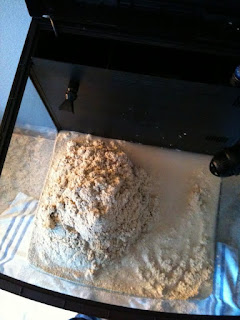First went the sand. I was wary about opening the second bag but went with it in the end. The sand bed ended up between 2 and 3.5 inches deep. After some negotiating and a little trial and error, I found a way to stack the rocks that gave me the desired layout- a bridge, several caves, hiding places, and no rocks leaning against glass. There is still room for another piece if I find one that has a good set of corals on it, and there is also open space on the sand bed for an open brain or plate coral... something that will fluoresce under the LED moon lights. The water was last; I put a clean glass plate over the rocks and poured the water onto it so as not to disturb the sand/substrate... an old trick that any aquarium keeper should know.
Altogether the whole process of aquascaping and filling the tank took approximately an hour and a half. As expected, the water was cloudy and the only shapes I could discern were rocks a few inches from the glass. Over the next day, suspended particulate settled down and eventually cleared up- earlier than I thought it would. By Sunday afternoon it was almost totally clear. The timers I bought are working well and all seems to be in order.
Succumbing to impatience, I did pick up some livestock a day after the tank had been set up. There are ten red-legged hermit crabs to start off the clean-up crew, a Scarlet Skunk Cleaner Shrimp (Lysmata amboinensis), and four small frags: Red & Green Zoanthids (not sure on the species), Star Polyps (Pachyclavularia violacea), and some tiny purple clove corals (Clavularia sp.). Not having to worry about liverock die-off or a full tank cycle is very convenient... minor cycles will happen when the bio load increases. I wouldn't recommend risking this kind of thing to anyone else, though. The stock advice is "wait at least a week".
Everything was properly acclimated- temperature matched and a cup of tank water mixed into the bag before release. The Zoanthids were opening up within an hour of being introduced to the tank, and by Sunday evening the cloves and star polyps were also opening up. I had to redirect the flow from the Koralia 1 and now it is pointing laterally across the back wall of the aquarium (towards the output of the stock pump). This creates a loose rotational current around the tank without too much direct flow or turbulence in any one place. With the stock pump and the Koralia, the total flow in the tank is roughly 22 times the tank volume per hour. That's lower than some SPS-only tanks, but way higher than your general minimum requirement.
I'll post in the coming days as I test water.












